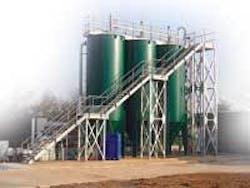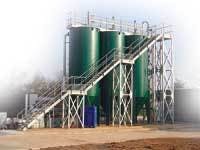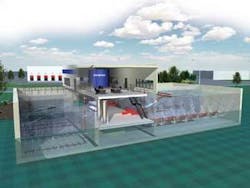Wastewater Industry Moving Toward Enhanced Nutrient Removal Standards
By Tony Freed
Most people involved in the wastewater industry are familiar with biological nutrient removal (BNR) where biological processes are incorporated into wastewater treatment systems to reduce effluent total nitrogen to an average level of 8 to 10 mg/L and total phosphorus to an average of 1 to 3 mg/L before being discharged into a receiving water. Certain receiving waters are showing evidence that BNR limits are not strict enough to protect water quality and, as a result, these levels are still causing unbalanced ecosystems.
A new acronym is therefore being thrown into the mix: enhanced nutrient removal or ENR. ENR further refines the BNR process and removes total nitrogen to levels as low as 3 mg/L and total phosphorus to 0.3 mg/L or less.
Low effluent nutrient limits are not necessarily a new concept. For decades, a few states such as Florida have had strict effluent nutrient regulations, similar to the new ENR limits, for surface water discharge. Not until the recent focus around the Chesapeake Bay has the term ENR gained recognition. This region is well under way to implementing strict water quality standards by 2010, under the Chesapeake Bay 2000 Agreement. The agreement was signed by Maryland, Virginia, Pennsylvania, and the District of Columbia to further reduce nitrogen and phosphorus entering the Bay by 20 million pounds and 1 million pounds per year, respectively.
The Pacific Northwest is another region where point source dischargers such as wastewater treatment plants are under growing pressure for nutrient removal. Receiving waters such as the Spokane River in Washington and Idaho have oxygen levels that are too low to support healthy fish populations. This low level of oxygen is caused by high nutrient concentrations, in this case primarily phosphorus.
With other state regulators taking a closer look at the quality of their receiving waters, what does this mean to the world of wastewater treatment? It means that wastewater treatment facilities have to plan their upgrades and expansions to include treatment processes to meet current compliance issues as well as those water quality standards anticipated in the future. Municipalities and utilities that proactively design and implement wastewater processes to meet the inevitable tightening of effluent nutrient limits may save time, money and headaches in the long run.
Achieving ENR Levels
How does a treatment system or facility reach those lower levels of nitrogen and phosphorus, or ENR? It is relatively simple for those wastewater facilities already achieving BNR. Usually tertiary filtration can be added to the existing treatment process with minimal alterations. Denitrification filters such as deep-bed or continuous backwash filters are an easy and economical addition to existing treatment systems that use biological processes to convert harmful nitrate-nitrogen into nitrogen gas, thus reducing effluent total nitrogen to 3 mg/L or less. In addition to biological denitrification, these filters provide physical/chemical treatment, using chemical phosphorus precipitation to achieve total phosphorus levels as low as 0.3 mg/L.
On the western shore of the Chesapeake Bay, Aberdeen (Md.) Proving Grounds WWTP has incorporated a continuous backwash filter to reduce its total nitrogen discharge from 7 mg/L to 3 mg/L. Applications requiring extremely low levels of phosphorus can benefit from such a packaged two-stage clarifier and filter combination system. Similarly, a paper mill near Spokane, Wash., is in the process of installing this technology after a successful pilot study proved phosphorus levels of 0.1 mg/L could be reliably achieved.
The Dahlgren WWTP in Virginia discharges into a tributary of the Potomac River that eventually empties into the Chesapeake Bay. In anticipation of the new ENR discharge limits, the King George Service Authority that owns the Dahlgren facility recently began expanding its existing oxidation ditch process and implementing an advanced process control system. Using these relatively inexpensive improvements, the authority anticipates meeting the stricter nutrient removal limits without requiring a major capital intensive upgrade.
For those treatment facilities that are not already achieving BNR, more capital costs may be involved. Fortunately, existing treatment facilities can benefit from simple upgrade or retrofit technologies provided by experienced water and wastewater treatment equipment suppliers. Many times, advanced technologies such as sequencing batch reactors, membrane bioreactors, or oxidation ditch and vertical loop reactors can be incorporated into existing treatment designs, taking advantage of existing tankage wherever possible. For example, the city of Fruitland, Md., upgraded its wastewater treatment from an antiquated trickling filter process to a 1 mgd sequencing batch reactor system to meet the more stringent limits at a significantly lower cost than building an entirely new treatment plant.
Conclusion
In essence, ENR is simply the next step in the natural technological progression of wastewater treatment processes, starting with primary treatment, through secondary and advanced treatment, then biological nutrient removal, and now enhanced nutrient removal. Regardless of a facility’s particular circumstances, a variety of innovative technologies and cost-effective processes can be called upon to meet these new challenges
About the Author:
Tony Freed is a product manager for Davco biological systems at Siemens Water Technologies in Thomasville, GA. He joined Siemens in 1989 and has worked in the industry since 1985. Freed has a BS degree in Microbiology from Central Michigan University in Mount Pleasant, Mich., and a MS degree in Environmental Microbiology from Georgia Tech University in Atlanta. He can be reached at 229-227-8749 or at [email protected].




